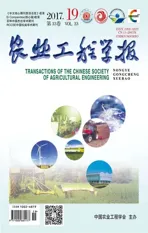便携式番茄多品质参数可见/近红外检测装置研发
2017-11-01李永玉彭彦昆
王 凡,李永玉,彭彦昆,李 龙
便携式番茄多品质参数可见/近红外检测装置研发
王 凡,李永玉※,彭彦昆,李 龙
(中国农业大学工学院,国家农产品加工技术装备研发分中心,北京 100083)
该文针对番茄独特的囊室结构及整体成熟度不均等问题,基于可见/近红外全透射光谱,研发了便携式番茄内外品质快速无损实时检测装置。该装置的硬件系统主要包括光源模块、信号采集模块、信号处理模块、电源模块、散热模块和打印模块,基于该硬件系统,采集了番茄630~1 100 nm范围内可见/近红外透射光谱,选取650~1 100 nm范围的光谱进行SG卷积平滑(savitzky-Golay smooth, SG-smooth)、标准正态变量变换(standard normal variable transformation, SNV)和多元散射校正(muliplication scattering correction, MSC)等预处理,建立了番茄颜色、硬度、总酸、总糖含量的偏最小二乘预测模型。基于QT开发框架编写了番茄多品质无损检测实时分析控制软件,植入番茄多品质参数预测模型,实现了番茄多品质参数检测一键式操作。为了测试该装置的检测精度和稳定性,选取与建模无关的20个同品种样品对每个样品的内外品质重复检测8次,结果表明:番茄颜色预测值与实测值相关系数为0.952 8,均方根误差为2.703 8,硬度预测值与实测值相关系数为0.940 5,均方根误差为0.448 6 kg/cm2,总酸含量的预测值与实测值相关系数为0.953 7,均方根误差为0.326 3%,总糖含量预测值与实测值相关系数为0.9610,均方根误差为0.197 4%。番茄样品颜色、硬度、总酸和总糖重复检测最大相对误差分别为2.9%、1.9%、2.0%和1.6%。该便携式检测装置基于可见近红外全透射光谱,实现了番茄颜色、硬度、总酸、总糖含量的同时快速无损实时检测,预测精度及稳定性较好,可以满足实时评价番茄品质的市场需求。
无损检测;光谱分析;模型;番茄;便携式装置;可见/近红外光谱
0 引 言
番茄以独特的风味和丰富的营养备受消费者的青睐,是世界上消费最广泛的蔬菜之一[1]。在很多国家番茄主要以鲜食方式流通,因此消费者对番茄的内外品质有着较高的要求。中国市售鲜食番茄大部分根据外观品质进行人工初步分选,但是消费者的满意程度更大程度上取决于番茄糖酸等内部品质。中国番茄内部品质检测主要依赖于传统化学分析方法,耗时、有损伤且难以满足现场检测的需求。
近年来,可见/近红外光谱技术广泛应用于各种水果和蔬菜的品质检测分选[2-7],出现了多种便携式近红外品质检测装置。利用近红外反射原理的蔬菜叶片品质检测装置、青番茄成熟度分级、谷物品种判别以及肉品新鲜度判别等嵌入式检测装置均达到了较高的检测精度[8-12]。另外,基于近红外漫透射原理的便携式苹果内部品质检测装置实现了对苹果可溶性固形物含量等内部品质的快速检测,最高相关系数达到0.951[13-15]。现今国内外市售的果蔬品质便携式检测装置大部分为基于近红外漫反射或漫透射光谱,采集信息为样品表皮附近的部分信息,适用于内部品质相对均匀的样品。
番茄具有独特的囊室结构而且一般整体品质分布不均匀,传统反射及漫透射的检测方式难以达到检测精度,而透射检测因需要光源、探头异侧,给便携式装置开发带来了较大的困难。本文针对番茄的特殊内部结构,基于可见近红外全透射光谱,研发番茄颜色、硬度、总酸、总糖含量的便携式快速无损检测装置,编写实时检测分析控制软件,实现番茄的主要内外品质的同时快速无损检测。
1 番茄品质检测装置设计
1.1 检测系统工作原理
便携式番茄多品质参数无损检测装置,针对番茄独特的囊室结构及其整体品质不均等问题,采集番茄完整样品的透射光谱曲线,检测番茄颜色、硬度、总酸、总糖等主要品质指标,其工作原理图如图1所示。将番茄样品置于仿形胶垫上,环形光源发出的光照射番茄样品底部,通过耦合透镜从番茄顶部采集透过样品的光谱信号并传送至光谱仪,光谱仪将光谱信号转换为数字信号传送至数据分析处理器,处理器根据内置的番茄各品质参数预测模型对数字信号进行实时分析,并在显示屏上输出检测结果,同时将结果打印为可粘贴的标签。
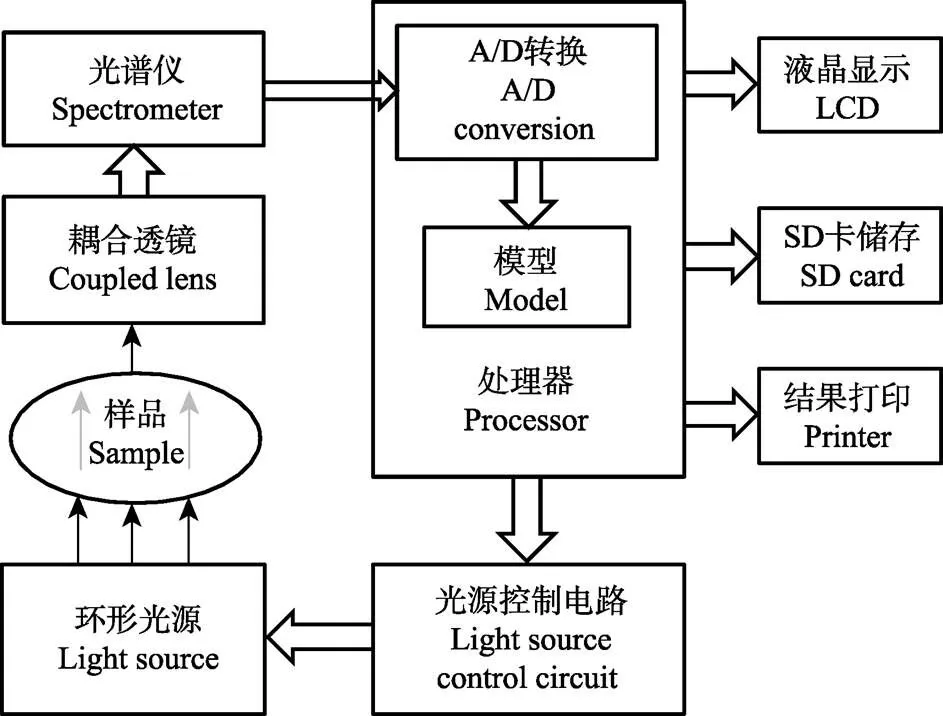
图1 系统工作原理框图
1.2 便携式番茄多品质参数无损检测装置硬件
1.2.1 控制处理模块
硬件系统主要由光源模块、信号采集模块、信号处理模块、电源模块、散热模块和打印模块组成,装置外形尺寸为240 mm´190 mm´70 mm,为了提高仪器的实用性,为装置配备容量为20 000 mA·h的可充电锂电池,在脱离电源的情况下可独立工作2 h。装置结构图和实物图如图2所示。

1. 光谱仪 2. 耦合透镜 3. 仿形胶垫 4. 环形光源系统 5. 散热风扇 6. 稳压板 7. 电源 8. 打印模块 9. 开发板及触摸屏 10. 总开关
1.2.2 光谱采集模块
光谱采集单元的功用是采集透过样品的光谱曲线,将光谱信息转换为数字信号,并传输给中央处理器。光谱采集单元由微型光谱仪和耦合透镜组成。
微型光谱仪采用海阳光学公司开发的STS微型光谱仪,其体积为40 mm´42 mm´24 mm,质量为68 g,光学分辨率为0.5 nm,波长相应范围为650~1 100 nm,参照参考700~900 nm为近红外评判水果内部品质指标的信息集中区[16-18],可以满足对果蔬内部品质的预测。
传统的可见/近红外无损检测中,光谱仪大多与光纤相连,但光纤不能轻易弯折,且传输过程中会有信号的损失,同时考虑到设备的便携性,本装置采用海洋光学的74-DA耦合透镜代替光纤。光谱仪与耦合透镜利用螺纹连接,并通过压板固定在手持部分中,由USB线与主机部分相连,不仅可以缩小仪器尺寸,同时避免了由光源及电源发热造成的光谱仪误差[19]。
1.2.3 光源模块
根据番茄的外形结构研制了光源模块,主要由果托、卤素灯珠、上压板和下压板组成,安装固定方式如图3所示。为了保证充足光照的同时不对样品造成热灼伤,在光源设计时采用分散功率的方式,使用8个5 W的卤素灯珠组成环形灯源,与下压板组装并固定在主机壳上。上压板对光源起保护的作用,其中央的环形凸台一方面起支撑样品的作用,另一方面避免光源照射果梗部分带来试验误差。果托的材质为橡胶,起辅助支撑的作用,同时可以根据样品的形状贴合在样品表面,防止光的溢出,降低由样品外形不同带来的误差。

1. 果托 2. 上压板 3. 灯珠 4. 灯座 5. 下压板
1.2.4 散热模块
由于装置的电源和光源都属于发热部件,因此必须对装置进行合理的散热。散热模块的设计准则为产热量与散热量相当。风扇排除的总热量为



其中1为装置产生热量(J),为仪器热功率(%),为仪器工作时间(h),则所需风量(m3/h)为

根据计算得出的风扇排量,选择排风量为5.97 m3/h,型号为YCL3510X的风扇2个,以一个正装一个反装的方式安装在仪器外壳上。
1.2.5 供电模块
选择了容量为20 000 mA·h的可充电锂电池,在脱离电源的情况下可独立工作2 h。同时为保证稳定的输出电压,配置了以LTC3780为芯片的稳压板,保证输出电压稳定在10 V,为光源及开发板供电。
1.2.6 打印模块
打印模块采用瑞工科技的RG-MLP80A,该打印机为无碳热敏打印,可选择50~80 mm大小的标签纸。当检测装置对样品进行预测时,开发板通过软件对打印机实现控制和传输,实时将检测结果通过USB接口传输至打印机,打印机以75 mm/s的速度实时打印标签,打印结果可直接粘贴于样品上。
2 番茄多品质参数预测模型建立
2.1 材料与方法
番茄品种为仙客一号,购买于北京市昌平区蔬菜种植基地。挑选无果病,表面无损伤的番茄共60个,其中40个用于模型的建立,20个用于外部验证。为消除温度对试验的影响,所有样品在采摘后均置于20 ℃条件下贮藏1 d后进行试验[20]。
将番茄多品质参数无损快速检测装置预热20 min,先对装置进行黑白参考的校正,然后采集番茄样品的透射光谱曲线,并根据公式(4)换算得番茄样品的光谱透射率,作为建立番茄多品质参数预测模型的光谱值。
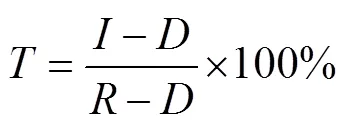
式中为番茄样品的透过率(%),为番茄样品的透过光谱强度(cd),为暗光谱强度(cd),为白参考光谱强度(cd)。
2.2 标准理化值测定
采集番茄光谱曲线后立即使用标准方法对番茄的内外部品质参数进行测定,检测方法如下:
硬度(kg/cm2)根据NY/T2009-2011[21]方法在番茄果顶部分随机选取4点进行测定取平均值。
颜色用精密色差仪(HP-200,上海汉普光电科技有限公司)在番茄果顶随机选取4点测定*、*、*参数值取平均,再按照空间转换方法将平均后的Lab参数转换为RGB参数,红色(Red,)值作为番茄颜色指标。
总糖(%)按照硫酸苯酚比色法[22]测定,每个番茄检测3个平行样品取平均值。
总酸(%)按照酸碱中和滴定法[23]测定,每个样品检测3个平行样品取平均值。
2.3 结果与分析
2.3.1 光谱预处理
40个番茄样品的原始透射光谱曲线如图4a所示。由于可见/近红外透射光谱两端噪声较大并伴有基线漂移等现象,故选取了650~1 100 nm波长范围,分别用10点SG卷积平滑(savitzky-golay smooth, SG-smooth)、标准正态变量变换(standard normal variable transformation, SNV)、一阶导数(first derivative, FD)、多元散射校正(muliplication scattering correction, MSC)、归一化(normalize, NOR)对原始光谱曲线进行了预处理[24-26],其中MSC和SNV预处理结果如图4b和图4c所示。

图4 40个样品不同预处理后的光谱曲线
2.3.2 番茄各品质参数预测模型
偏最小二乘回归法(partial least squares regression, PLSR)是常用的光谱定量分析建模方法[27]。它是多因变量对多自变量的回归建模,集主成分分析、典型相关分析和多元线性回归分析3种分析方法的优点于一身,将样品按3∶1的比例随机分为校正集与验证集,对预处理后的光谱曲线分别建立PLS模型,模型质量用校正集相关系数(correlation coefficient of calibration,)、验证集相关系数(correlation coefficient of validation,)校正集均方根误差(root mean square error of calibration, RMSEc)和预测集均方根误差(root mean square error of validation, RMSEv)评定,相关系数和相对分析误差越高,均方根误差越低,所建立的预测模型越稳定。模型结果如表1所示。
结果显示,采用MSC预处理后的番茄颜色预测模型效果最好,其校正集和验证集相关系数分别为0.964 1和0.963 0,均方根误差分别为1.514 8和1.629 6。采用SNV预处理的番茄硬度预测模型效果最好,其校正集和验证集相关系数分别为0.964 9和0.950 1,均方根误差分别为0.233 0 kg/cm2和0.335 9 kg/cm2。采用SNV预处理的番茄总酸预测模型效果最好,其校正集和验证集相关系数分别为0.986 9和0.981 8,均方根误差分别为0.085%和0.209%。采用SNV预处理的番茄总糖预测模型效果最好,其校正集和验证集相关系数分别为0.981 4和0.965 9,均方根误差分别为0.096 2%和0.107 2%。
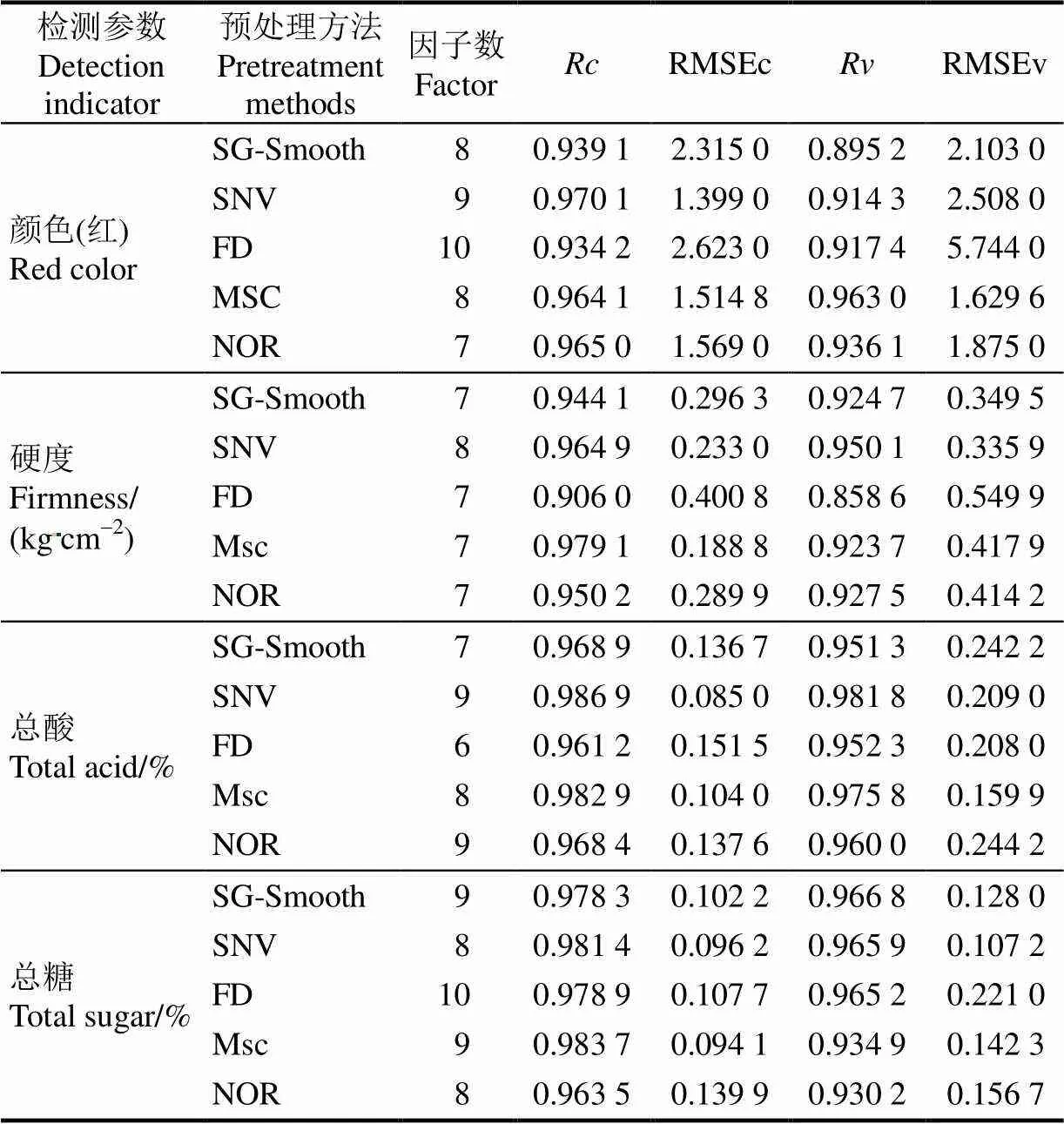
表1 不同预处理后的建模结果
3 便携式番茄多品质无损检测软件开发
基于QT开发工具编写了番茄多品质无损检测实时分析控制软件[28-31],实现了番茄多品质参数检测一键式操作,如图5所示。软件系统分为光谱仪控制模块、模型载入模块、光谱数据处理模块、检测结果显示和保存模块、结果打印模块。光谱仪控制模块主要实现对光谱仪积分时间、平均次数的设置以及黑白参考的校正;模型载入模块可以载入番茄多品质参数的预测模型;光谱数据处理模块对采集到的光谱数据进行MSC和SNV预处理并分别带入建立的模型中进行品质参数的预测;检测结果显示和保存模块可以将光谱曲线和检测结果实时显示在LCD屏幕,并对检测结果进行编号、保存;打印模块可以通过对打印机的控制实时打印预测结果。软件界面如5所示,使用时,首先点击“White”和“Dark”按钮分别对光谱仪进行白参考和暗噪声的校正,点击“Acquire”按钮采集样品的光谱曲线并利用内置模型进行内部品质的预测;点击“Exit”按钮可退出软件;番茄品质无损检测软件还可以实现对打印机的控制,当需要实时打印结果时,点击“Print”选项中的“ON”,点击“OFF”时关闭打印功能。
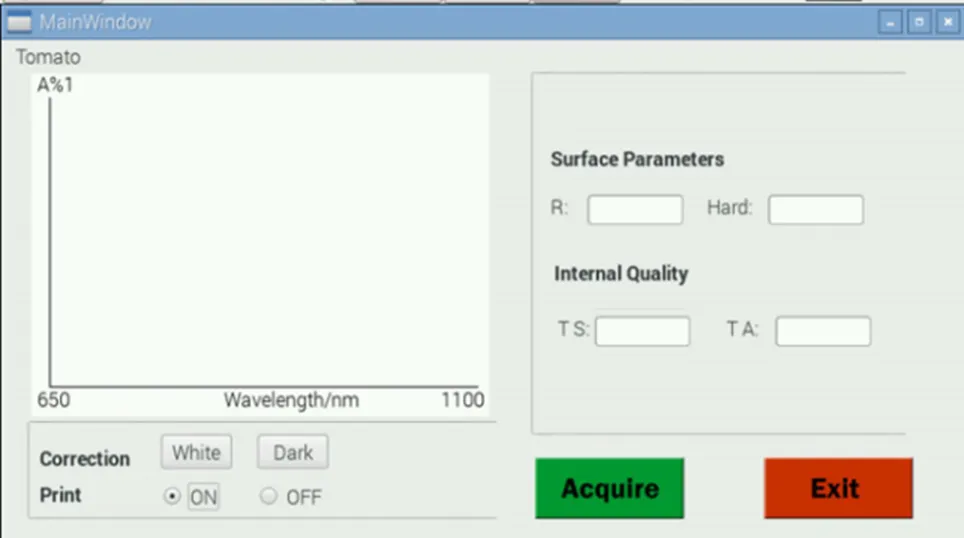
图5 软件界面
4 便携式番茄多品质无损检测装置测试
选取不同成熟度的20个番茄样品对便携式番茄多品质检测装置进行外部验证,检验仪器的稳定和精度,对每个番茄重复测定8次颜色、硬度、总酸和总糖的含量,同时与化学方法测得的标准值进行了比较分析。
便携式番茄多品质检测装置的稳定性试验结果如表2所示。将每个样品的8次检测的结果与平均值作比较,用最大相对误差衡量仪器的稳定性。结果显示,番茄颜色(红)最大相对误差为2.9%,硬度的最大相对误差为1.9%,总酸含量的最大相对误差为2.0%,总糖含量的最大相对误差为1.6%,各个品质参数的相对误差较小,该装置对各指标的预测稳定性较好。

表2 装置重复性和稳定性检验
番茄颜色、硬度、总酸以及总糖的预测值与实测值散点图如图6所示。颜色预测模型的相关系数为0.952 8,均方根误差为2.703 8;硬度预测模型的相关系数为0.940 5,均方根误差为0.448 6 kg/cm2;总酸预测模型的相关系数为0.953 7,均方根误差为0.326 3%;总糖预测模型的相关系数为0.961 0,均方根误差为0.197 4%。结果显示,该装置可以实现番茄颜色、硬度、总酸以及总糖的快速无损实时检测。

图6 试验测试结果
5 结 论
1)针对番茄独特的囊室结构及整体成熟程度不均等问题,基于可见近红外全透射光谱,研发了便携式番茄内外品质快速无损检测装置,硬件系统包括光源模块、信号采集模块、信号处理模块、电源模块、散热模块和打印模块。
2)基于所研发的便携式番茄多品质参数硬件系统,采集番茄650~1 100 nm范围可见/近红外全透射光谱,利用SG卷积平滑(savitzky-Golay smooth, SG- smooth)、标准正态变量变换(standard normal variable Transformation, SNV)和多元散射校正(muliplication scattering correction, MSC)等方法对采集的光谱进行了预处理,建立了番茄颜色、硬度、总酸、总糖含量的偏最小二乘预测模型。番茄颜色的预测模型的校正集和验证集相关系数分别为0.964 1和0.963 0,均方根误差分别为1.514 8和1.629 6;番茄硬度预测模型的校正集和验证集相关系数分别为0.964 9和0.950 1,均方根误差分别为0.233 0和 0.335 9 kg/cm2;番茄总酸预测模型的校正集和验证集相关系数分别为0.986 9和0.981 8,均方根误差分别为0.085%和0.209%;番茄总糖预测模型的校正集和验证集相关系数分别为0.981 4和0.965 9,均方根误差分别为0.096 2%和0.107 2%。
3)基于QT开发工具编写了番茄多品质无损检测实时分析控制软件,将所建番茄多品质参数预测模型植入到装置中,实现了番茄多品质参数检测一键式操作。
4)对便携式番茄内外品质快速无损检测装置稳定性及检测精度进行了测试。结果显示,番茄颜色预测值与实测值相关系数为0.952 8,均方根误差为2.703 8,硬度预测值与实测值相关系数为0.940 5,均方根误差为 0.448 6 kg/cm2,总酸含量的预测值与实测值相关系数为0.953 7,均方根误差为0.326 3%,总糖含量预测值与实测值相关系数为0.961 0,均方根误差为0.197 4%。番茄样品颜色、硬度、总酸和总糖重复检测8次最大相对误差分别为2.9%、1.9%、2.0%和1.6%。
该便携式番茄内外品质快速无损检测装置,基于可见近红外全透射光谱,实现了番茄颜色、硬度、总酸、总糖含量的同时快速无损实时检测,预测精度及稳定性较好,可以满足实时评价番茄品质的需求。在本研究中,硬件部分专为番茄特殊囊室结构而设计,但预测模型针对仙客一号品种而建立,因此预测其他品种番茄品质需模型传递等方法更新预测模型才会达到理想的预测精度。
[1] Scibisz I, Reich M, Bureau S, et al. Mid-infrared spectroscopy as a tool for rapid determination of internal quality parameters in tomato[J]. Food Chem , 2011, 125(4): 1390-1397.
[2] 刘燕德,应义斌,傅霞萍. 近红外漫反射用于检测苹果糖度及有效酸度的研究[J]. 光谱学与光谱分析,2005,25(11):1793-1796. Liu Yande, Ying Yibin, Fu Xiaping. Study on predicting sugar content and valid acidity of apples by near/infrared diffuse reflectance technique[J]. Spectroscopy and Spectral Analysis, 2005, 25(11): 1793-1796. (in Chinese with English abstract)
[3] 杨昆程,孙梅,陈兴海. 水果成熟度的高光谱成像无损检测研究[J]. 食品科学技术学报,2013,33(4):63-67. Yang Kuncheng, Sun Mei, Chen Xinghai. Nondestructive inspect of fruit maturity with hyperspectral imaging technology[J]. Journal of Food Science and Technology, 2015, 33(4): 63-67. (in Chinese with English abstract)
[4] Yuan L M, Sun L, Cai J R, et al. A preliminary study on whether the soluble solid content and acidity of oranges predicted by near infrared spectroscopy meet the sensory degustation[J]. Jounal of Food Process Engineering, 2015, 38(4): 309-319.
[5] 韩东海,常冬,宋曙辉,等. 小型西瓜品质近红外无损检测的光谱信息采集[J]. 农业机械学报,2013,44(7):174-178. Han Donghai, Chang Dong, Song Shuhui, et al. Information collection of mini watermelon quality using near-infrared non-destructive detection[J]. Transactions of the Chinese Society for Agricultural Machinery, 2013, 44(7): 174-178. (in Chinese with English abstract)
[6] 孙通,许文丽,林金龙,等. 可见/近红外漫透射光谱结合CARS变量优选预测脐橙可溶性固形物[J]. 光谱学与光谱分析,2012,32(12):3229-3233. Sun Tong, Xu Wenli, Lin Jinlong, et al. Determination of solube solids content in navel oranges by Vis/NIR diffuse transmission spectra combined with CARS method[J]. Spectroscopy and Spectral Analysis, 2012, 32(12): 3229-3233. (in Chinese with English abstract)
[7] 王辉,田寒友,张顺亮,等. 便携式中波近红外光谱仪在线无损检测生鲜猪肉胆固醇[J]. 光谱学与光谱分析,2017,37(6):1759-1764. Wang Hui, Tian Hanyou, Zhang Shunliang, et al. On-line noninvasive prediction of cholesterol level of fresh pork within NIR medium wavelength region with portable Near- Infrared spectrometer[J]. Spectroscopy and Spectral Analysis, 2017, 37(6): 1759-1764. (in Chinese with English abstract)
[8] 史增芳,姜岩蕾. 一种便携式玉米叶片含水检测仪器设计[J]. 农机化研究,2016,38(8):96-100. Shi Zengfang, Jiang Yanlei. Design of a portable instrument for measuring water content of corn leaves[J]. Journal of Agricultural Mechanization Research, 2016, 38(8): 96-100. (in Chinese with English abstract)
[9] 于渤,韩书庆,孙明. 便携式叶绿素计的设计与性能测试[J]. 农机化研究,2011,33(3):96-99. Yu Bo, Han Shuqing, Sun Ming. Design and performance of a portable chlorophyll meter[J]. Journal of Agricultural Mechanization Research, 2011, 33(3): 96-99. (in Chinese with English abstract)
[10] 魏文松,彭彦昆. 手持式生鲜肉品质参数无损检测装置研究[J]. 农业机械学报,2016,47(增刊1):324-331,339. Wei Wensong, Peng Yankun. Research on hand-held device for nondestructive detection of meat quality parameters[J]. Transactions of The Chinese Society for Agricultural Machinery, 2016, 47(Supp.1): 324-331, 339. (in Chinese with English abstract)
[11] 孙宏伟,彭彦昆,林琬. 便携式生鲜猪肉多品质参数同时检测装置研发[J]. 农业工程学报,2015,31(20):268-273. Sun Hongwei, Peng Yankun, Lin Wan. Development of a portable device for simultaneous detection on multi-quality attributes of fresh pork[J]. Transactions of the Chinese Society of Agricultural Engineering (Transactions of the CSAE), 2015, 31(20): 268-273. (in Chinese with English abstract)
[12] 郭志明,陈全胜,张彬,等. 果蔬品质手持式近红外光谱检测系统设计与试验[J]. 农业工程学报,2017,33(8): 245-250. Guo Zhiming, Chen Quansheng, Zhang Bin, et al. Design and experiment of handheld near-infrared spectrometer for determination of fruit and vegetable quality[J]. Transactions of the Chinese Society of Agricultural Engineering (Transactions of the CSAE), 2017, 33(8): 245-250. (in Chinese with English abstract)
[13] 樊书祥,黄文倩,张保华,等. 便携式苹果糖度光谱检测仪的设计与试验[J]. 红外与激光工程,2014,43(增刊1): 219-224.
Fan Shuxiang, Huang Wenqian, Zhang Baohua, et al. Design and experiment on portable apple soluble solidscontent spectrometer[J]. Infrared and Laser Engineering, 2014, 43(Supp.1): 219-224. (in Chinese with English abstract)
[14] Yuan Leiming, Cair Jianrong, Sun Li, et al. Nondestructive measurement of soluble solids content in apples by a portable fruit analyzer[J]. Food Analytical Methods, 2016, 9(3): 785-794.
[15] Gopal Tiwari, David C Slaughter, Marita Cantwell. Nondestructive maturity determination in green tomatoes using a handheld visible and near infrared instrument[J]. Postharvest Biology and Technology, 2013, 86(12): 221-229.
[16] Fraser D G, Künnemeyer R. Letter to the Editor[J]. PostharvestBiol Technol, 2001, 22(3): 191.
[17] Zou Xiaobo, Zhao Jiewen, Malcolm J W Povey. Variables selection methods in near-infrared spectroscopy[J]. Analytica Chimica Acta, 2010, 667(1): 14-32.
[18] Zhu Q, He C, Lu R, et al. Ripeness evaluation of ‘Sun Bright’ tomato using optical absorption and scattering properties[J]. Postharvest Biology and Technology, 2015, 103(5): 27-34.
[19] Zheng Yuquan. Precise spectral calibration for hyperspectral imager[J]. Optics and Precision Engineering, 2010, 18(11): 2348-2354.
[20] 李勇,魏益民,王锋. 影响近红外光谱分析结果准确性的因素[J]. 核农学报,2005,19(3):236-240. Li Yong, Wei Yimin, Wang Feng. Affecting factors on the accuracy of near-Infrared spectroscopy analysis[J]. Acta Agriculturae Nucleatae Sinica, 2005, 19(3): 236-240. (in Chinese with English abstract)
[21] NY/T2009-2011, 水果硬度的测定[S].
[22] Dubois M, Gilles K A, Hamilton J K , et al. Colorimetric method for determination of sugars and related substances[J]. Nature, 1951, 28(7): 167.
[23] GB/T 12456-2008, 食品中总酸的测定[S].
[24] 梁逸曾,许青松. 复杂体系仪器分析—白、灰、黑分析体系及其多变量解析方法[M]. 北京:化学工业出版社,2012:474.
[25] 林中,范世福. 光谱仪器学[M]. 北京:机械工业出版社,1989.
[26] 陆婉珍,袁洪福,徐广通,等. 现代近红外光谱分析技术[M]. 北京:中国石化出版社,2000.
[27] 刘树深,易忠胜. 基础化学计量学[M]. 北京:科学出版社,1999.
[28] 余志峰,丁锋. 信息系统人机界面设计的基本原则[J]. 网络信息技术,2004,23(3):44-45. Yu Zhifeng, Ding Feng. Design principles of man-machine interface for information system[J]. Network Information Technique, 2004, 23(3): 44-45. (in Chinese with English abstract)
[29] 郑阿奇,陈超. Qt4开发实践[M]. 北京:电子工业出版社,2011.
[30] Hartson H R. Human-computer interact-ion: Interdiscip- linary roots and trends[J]. The Journal of System and Software, 1998. 43: 103-118.
[31] 何剑锋,邬文彪,李宏穆,等. 嵌入式Linux系统的Qt/ Embedded图形界面开发[J]. 电子工程师,2007,3(7): 46-48. He Jianfeng, Wu Wenbiao, Li Hongmu, et al. Development of Qt/embedded graphical interface based on ARM920 TEmbedded linux system[J]. Electronic Engineer, 2007, 3(7): 46-48. (in Chinese with English abstract)
王 凡,李永玉,彭彦昆,李 龙. 便携式番茄多品质参数可见/近红外检测装置研发[J]. 农业工程学报,2017,33(19):295-300. doi:10.11975/j.issn.1002-6819.2017.19.038 http://www.tcsae.org
Wang Fan, Li Yongyu, Peng Yankun, Li Long. Development of portable device for simultaneous detection on multi-quality attributes of tomato by visible and near-infrared[J]. Transactions of the Chinese Society of Agricultural Engineering (Transactions of the CSAE), 2017, 33(19): 295-300. (in Chinese with English abstract) doi:10.11975/j.issn.1002-6819.2017.19.038 http://www.tcsae.org
Development of portable device for simultaneous detection onmulti-quality attributes of tomato by visible and near-infrared
Wang Fan, Li Yongyu※, Peng Yankun, Li Long
(100083,)
In order to meet the demand of quality control in the process of fruit and vegetable processing, a portable fast non-destructive testing device for portable tomato was developed based on the visible / near-infrared transmission spectrum.Based on the analysis of the difficulties in the development of portable devices with near infrared transmission spectra, a portable design system of tomato quality was proposed. The system of the device mainly included the light source, the signal acquisition module, the signal processing module, the power, the heat dissipation module and the printer. The light source consists of 8 5 W halogen lamps that provide a light source for the sample. The spectrometer is connected to the focusing lens and collects the spectral curve through the sample. In order to solve the volumetric problem of the transmission spectrum detection scheme, the spectrometer and the coupling lens are mounted on the hand-held member. The development board has a tomato multi-quality parameter prediction model, the curve collected by the spectrometer is processed, and the prediction results are displayed on the LCD (liquid crystal display). This device can print the test results in real time through the print module. Based on this device, the visible and near-infrared total transmission spectra of tomato in the range of 650-1100 nm were collected, and the collected spectra were pretreated by Savitzky-Golay Smooth (SG-Smooth), standard normal variable transformation (SNV), first derivative (FD), multiplication scattering correction (MSC) and Normalization (NOR). The partial least squares prediction model of color and hardness, total acid and total sugar content of the tomato was established. In addition, based on QT development tools, tomato multi-quality non-destructive testing real-time analysis and control software was prepared. The multi-quality parameter prediction model of tomato was implanted into the device to predict the quality of the tomatoes. Finally, the stability and detection accuracy of the portable fast and non-destructive testing device of tomato were tested, and 20 samples were selected for repeated detection of the internal and external quality of tomato. The results showed that the correlation coefficient of tomato color between the predicted value and the measured value was 0.952 8, and the root mean square error was 2.703 8; the correlation coefficient of firmness between the predicted value and the measured value was 0.940 5, and the root mean square error is 0.448 6 kg/cm2; the correlation coefficient of the total acid content was 0.953 7, and the mean square error was 0.326 3%; the correlation coefficient of total sugar of tomato between the predicted value and the measured value was 0. 961 0 and the root mean square error was 0.197 4%.The maximum relative errors of red color, hardness, total acid and total sugar under repeated detection for tomato samples were 2.9%, 1.9%, 2.0% and 1.6%, respectively. In conclusion, the field application results indicate that this portable device can satisfy the requirements of tomato quality detection with high accuracy and good performance. The results provide the reference for rapid, non-destructive, and on-site detection technology and equipment of fruit internal quality.
nondestructive detection; spectrum analysis; models; tomato; portable equipment; visible/near infrared spectroscopy
10.11975/j.issn.1002-6819.2017.19.038
TS251.7; S237
A
1002-6819(2017)-19-0295-06
2017-06-07
2017-08-08
国家科技支撑项目(2014BAD04B05)
王 凡,吉林人,博士生。研究方向:农畜产品品质安全无损检测技术及装备。北京 中国农业大学工学院,10083。 Email:wangfan0313@126.com
※通信作者:李永玉,吉林人,副教授,博士生导师。研究方向:农畜产品品质安全无损检测技术及装备。北京 中国农业大学工学院,100083。 Email:yyli@cau.edu.cn
